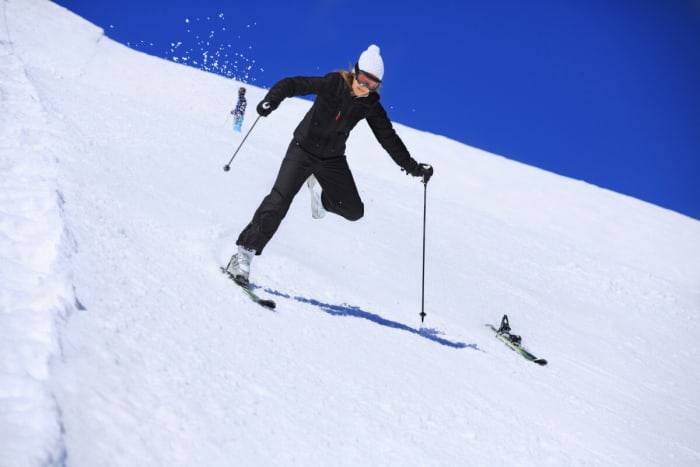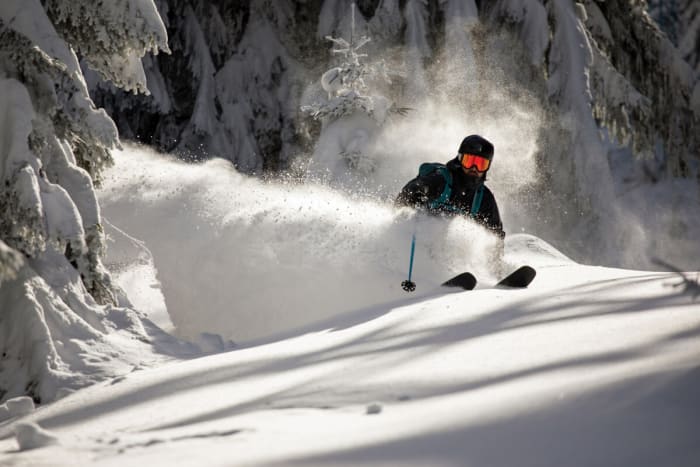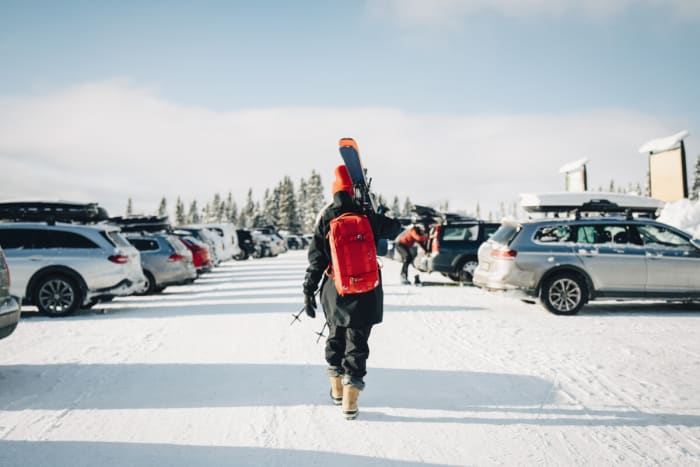
Skiing has a reputation for being difficult to approach. It’s expensive, cold, and, to be frank, quite hard. Few other sports require excellent hand-eye (hand-foot?) coordination while taking place in a literal outdoor icebox. Try to avoid being daunted, though. The hurdles associated with skiing, while large, are worth overcoming. Stellar views and new friends wait on the other side.
These are eight tips from POWDER's staff to help you get started.

1. Dial in Your Kit
Gear Editor Max Ritter:
Don't let anyone tell you that gear doesn't matter. It absolutely does. However, that doesn't mean you need to be spending exorbitant amounts of money buying the latest, greatest, fanciest gear. Rather, I mean you should find gear that's appropriate for a beginner to intermediate skier, giving you the chance to grow into it as you start progressing and saving you the hassle of dealing with your equipment failing while you're out on the hill. That way, you can focus on skiing and not staying warm, dealing with crappy skis, or having issues with your boots.
The two most important investments in gear to get you going skiing are appropriate apparel and properly fitting ski boots. It can be daunting to drop hundreds of dollars to go see a boot fitter, but it's an investment that will last you many years to come. Simply put, skiing's no fun when your feet hurt, and comfortable ski boots are absolutely something money can buy.
Secondly, proper attire will keep you warm, dry, and happy on the hill. See here for our full guide on layering.
2. Wear a Helmet!
Gear Editor Max Ritter:
Please wear a helmet. Falling is a big part of learning to ski, and protecting your brain with a properly fitting and officially rated ski helmet is a must. Traumatic brain injuries are no joke, and a helmet is a proven way to help prevent them. If you do take a crash and think you've hit your head, check that brain bucket and replace it if there's any sign of damage—helmets are designed to crack in order to dissipate the forces when you hit the ground.
If you're looking for a little extra protection for your body, consider wearing padded shorts to avoid bruised hips or even a back protector.

3. Remember, Learning Takes Time!
Izzy Lidsky:
Like learning any new skill, learning to ski takes time. Sliding down a hill on two planks with your feet crammed into a medieval torture device parading as technical gear is not an intuitive motion for our bodies. You're not going to learn to ski overnight. So be patient with yourself!
It's certainly easy to get frustrated when you see clips on Instagram or folks around you skiing so well, but remember that all those people started somewhere, too. The more patient you are with yourself throughout the learning process, the easier it will be to absorb new information and avoid getting injured while you're learning.
4. Get in Shape
Izzy Lidsky:
While skiers may have gained themselves a bit of a reputation for living off beer, burgers, and fries, the best skiers are highly trained athletes. Even if you're not hoping to ski like Johnny Collinson, it's worth taking a leaf out of his book and hitting the gym before you hit the slopes. You'd be shocked at how many different weird workouts can benefit your on-mountain game.

5. Ski With People That Are Better Than You
Izzy Lidsky:
When you're learning a sport, it can be pretty intimidating to do it with people who are a lot better or more experienced for a number of reasons. However, if you can find a crew that will let you tag along or doesn't mind hanging out in some mellower terrain, there's a ton of value to skiing casually with people who are more advanced than you.
Speaking from experience, I was literally surrounded by people who were way better than I was at skiing when I lived in Jackson Hole. Spending four years watching them ski, watching their technique, or how they approached different types of snow or lines helped my own skiing so much. You can learn a ton from watching other people, getting skills explained in a new way, or just having them encourage you to try new things on skis!
6. Pick a Mountain With Affordable Lift Tickets
Ian Greenwood:
No matter what level of skier you are, it's easy to get sucked into the "destination" resort hype. Bigger trails, longer lifts, fancy on-mountain lodging—the list of features these spots boast is long, but they typically charge a premium in the form of expensive lift tickets that can cost $200 or more. Thankfully, if you're learning to ski, you don't necessarily need the highest caliber experience. Instead, a gentle slope or two will do the trick.
So, think about finding a ski area that's cheap and has minimal frills as you get your ski boots under you. Some mountains offer affordable beginner-oriented tickets that only provide access to one or two lifts, which is another option worth checking out. Start small—your wallet will thank you. The "destination" experience can wait.

7. Arrive at the Mountain Early
Ian Greenwood:
The ski slopes are busier than ever, particularly when the snow starts to pile up. Weekends can make matters worse. To avoid playing an unpleasant version of musical chairs in the ski resort parking lot, hit the road earlier than you think you need to on days that might be busy. That could be 6 a.m. It might be earlier.
The rhythms of every ski resort vary, so dialing in your departure times may take some experimentation, but know this: having to hang out in the lodge for an hour because you arrived before the lifts start spinning beats the alternative. Trust me, I've done both. During the fall and spring, you usually can get away with sleeping in a little bit, but be careful about pushing your luck. Nothing sours a ski day like spending 45 minutes to find a place to leave your car.
8. Try Skiing in the Spring
Ian Greenwood:
On the note of crowded slopes—navigating a skier-choked run is unpleasant for everyone, but it can be particularly scary for beginners. You can avoid the rat race, though. By mid-April or so, the majority of people tend to get bored with skiing. Perhaps they have a long-overdue yard work project. Maybe they've been waiting for an excuse to try out their new mountain bike. Either way, ski resorts, as a general rule, are less busy in the spring.
This can make for a more laid-back learning experience that doesn't involve dodging out-of-control teenagers. Plus, skiing when it's 50 degrees and sunny removes one of the more unpleasant aspects of snowsports for first-timers: the cold.
More must-reads:
- First-round draft pick Jahdae Barron finally inks rookie deal with Broncos
- LeBron James' agent warns NBA media about his retirement
- The 'MLB Home Run Derby champions' quiz
Breaking News
Trending News
Customize Your Newsletter
 +
+
Get the latest news and rumors, customized to your favorite sports and teams. Emailed daily. Always free!








